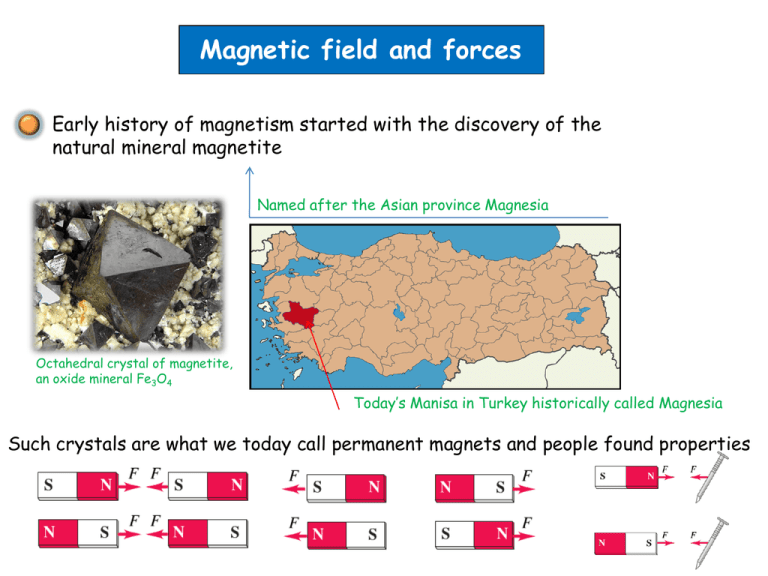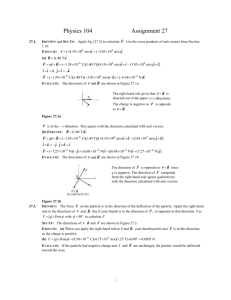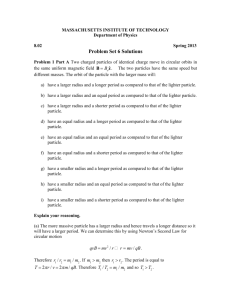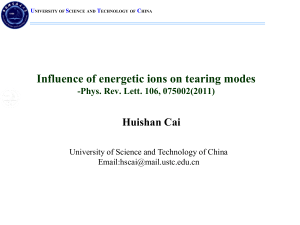Magnetic fields and forces
advertisement

Magnetic field and forces Early history of magnetism started with the discovery of the natural mineral magnetite Named after the Asian province Magnesia Octahedral crystal of magnetite, an oxide mineral Fe3O4 Today’s Manisa in Turkey historically called Magnesia Such crystals are what we today call permanent magnets and people found properties Modern HDD Chinese compass invented 2230 years ago Instead of following the traditional (textbook) approach to first introduce the phenomena we start by highlighting here the modern insight that Electric forces and fields and magnetic forces and fields are unified through relativity What led me more or less directly to the special theory of relativity was the conviction that the electromotive force acting on a body in motion in a magnetic field was nothing else but an electric field. -Einstein 1953http://en.wikipedia.org/wiki/Relativistic_electromagnetism The origin of magnetic forces on a moving electric charge A first hint at a fundamental connection between electricity and magnetism comes from Oersted’s experiment Electric phenomenon Magnetic phenomenon A distribution of electric charges creates an E-field A moving charge or a current creates (an additional) magnetic field The E-field exerts a force F=q E on any other charge q The magnetic field exerts a force F on any other moving charge or current Where are the moving charges or currents in a permanent magnet? We see later more clearly that these are the “moving electrons” on an atomic level (angular momentum L, spin S, J=L+S) How can relativity show that a moving charge next to a current experiences a force Let’s consider the special case that our test charge outside the wire moves likewise with v, the drift velocity of the electrons in the wire drift velocity of electrons, remember Drude model of conductivity wire of infinite length charge density Q / l0 Negative charge (electrons) flowing to the right Stationary positive ions Now we look at the situation from the perspective of the moving test charge q: we transform into the moving coordinate system of the test charge From the perspective (moving reference frame) of the test charge electrons are at rest and ions move Now the “magic” of special relativity kicks in: Spaceship moving with 10% of speed of light Spaceship moving with 86.5% of speed of light Lorentz-contraction quantified by http://www.physicsclassroom.com/mmedia/specrel/lc.cfm v l l0 1 c 2 Due to Lorentz-contraction: test charge sees modified charge density for moving + ions Q l Q l0 v 1 c 2 v 1 c 2 test charge sees imbalance of charge density for electrons and + ions Since v-drift is about 0.1 mm/s <<c (see http://physics.unl.edu/~cbinek/Unit_13%20Current%20resistance%20and%20EMF.pptx) we can expand into Taylor series around x=v/c=0 1 x2 2 f ( x) f (0) f (0) x f (0) x ... 1 ... 2 2 2 1 x 1 v2 2c 2 Charge density of ions increased in the frame of the test charge Likewise in comparison to lab frame (frame of the wire) the electrons are now seen at rest (were moving in the lab frame) v2 test charge sees charge density of electrons reduced by 2 (because test charge at rest sees wire as neutral despite moving negative charges) 2c Net effect: wire neutral in the lab frame gets charge density in the frame of moving electron v2 c2 Remember the electric field of an infinite wire with homogeneous charge density Gaussian cylinder of radius r l 2 E d r E 2 r l Q 0 E 2 0 r For the moving charge in the moving frame we have Moving charge sees an electric field E 1 v2 c2 v2 2 0r c2 charge is exerted to a force away from the wire q v 2 F 2 0r c 2 In the lab frame (frame of the wire) we interpret this as the magnetic Lorentz force c2 F qv v qvB 2 2 0r c with B 1 0 0 v v I 0 0 2 2 0r c 2 r 2 r magnetic B-field in distance r from a wire carrying the current I Our expression F qvB holds for the special case I B F qvB v In general: F q v B magnetic force on a moving charged particle vB Clicker question Considering the mathematical cross product structure of the Lorentz force. Do you think that this magnetic force can do work on a charge? 1) Yes, it is a force and we can evaluate 2) No, the integral Fd r Fd r will always be zero 3) Yes, the integral Fd r will equal qvBl where l is the length of the path The e/m tube demonstration We see Lorentz force F v and hence dr Circular orbit qvB m 2 v R v known from Ekin=qVab 𝑞 𝑣 = 𝑚 𝐵𝑅 B known from current through Helmholtz coils e/m= 1.76 x 1011 C/kg measure R vs. B no work With v R c : qB m Cyclotron frequency http://en.wikipedia.org/wiki/Cyclotron From F qv B qvB [ B] we can determine the unit of the B-field [F ] N N : T [q][v] As m / s Am 1T=1tesla=1N/Am in honor of Nikola Tesla http://en.wikipedia.org/wiki/Nikola_Tesla A moving charged particle in the presence of an E-field and B-field F q E v B An application in modern research: the Wien mass filter Resolution: m/Δm > 20@5 keV http://www.specs.de/cms/front_content.php?idart=148 It selects defined ions by a combination of electric and magnetic fields. aperture aperture z x y The charged particle will only follow a straight path through the crossed E and B fields, if net force acting on it is zero q E v B 0 For the simple special case: q E vB e y 0 v (v,0,0) , E (0, E ,0) , B (0,0, B ) ex ey ez vB v 0 0 vBe y 0 0 B E v B Wien filter can be used for mass selection if incoming particles have fixed kinetic energy v 2Ekin / m Is that the whole story of the Wien filter Absolutely not, as this research manuscript from 1997 indicates v ( v x , v y , v z ) , E (0, E ,0) , B (0,0, B ) ex ey ez v B vx 0 vy 0 v z v y Be x v x Be y B Equation of motion for particle of charge q and mass m in the filter: mr q E v B Do not click if you are not prepared to see nastiness. m x qv y B m y qE qv x B mz 0 viewer discretion is advised! coupled differential equations, nasty! z(t ) vzt But, we are honors students: Not the goal but the game Not the victory but the action In the deed the glory m x qyB x m y qE qxB qB y m x qB qE qB x m m m We define x vx 2 E 2 v x c c vx B Back to c qB m introduced earlier already as cyclotron frequency Solving first the homogeneous equation vx c vx 0 2 Ansatz vx Asin t v x A cos t v x A sin t Substitution into homogeneous differential equation 2 Asin t c Asin t 0 c 2 E Solving the inhomogeneous equation v x c v x c B through 2 2 Solution of inhomogeneous equation is general solution of homogeneous plus a particular solution of inhomogeneous For the particular solution we try vx const vx 0 E vx B E With v x c v x c B 2 2 is a solution General solution of inhomogeneous differential equation vx E a sin ct b cos ct B particular solution of general solution of inhomogeneous differential eq. homogeneous differential eq. E a b x(t ) t cos ct sin ct c B c c With x(t=0)=0 x (t ) c a / c E a b t 1 cos ct sin ct B c c E y c x c B E y c t x(t ) c c B a 1 cos ct b sin ct c y at a c sin ct b c cos ct ct d Final adjustment of initial conditions: v x (t 0) v x 0 E b B b vx 0 E B v y (t 0) v y 0 c b y (t 0) y0 d c vx (0) cv y 0 ac a vy0 c vy0 vx 0 E E x (t ) t 1 cos t c sin ct B c c Bc y (t ) y0 v E sin ct x 0 1 cos ct c c Bc vy0 Can we recover the simple case of acceleration free motion? Motion is simple for from =0 v y (t 0) v y 0 0 and y (t 0) y0 0 =0 vx 0 E y (t ) y0 sin ct 1 cos ct c c Bc vy0 =0 This is of course the condition E vx0 B motion with y(t)=0 for the entire path in the filter aperture aperture z No net force x y In fact: =0 =0 vy0 vx 0 E E x (t ) t 1 cos ct sin ct B c c Bc x (t ) E t B In general motion is very complex Let’s consider charged particle with mass M0 moving with constant v through EXB particle with mass M=M0 / has different initial v than particle with M0 Trajectory deviates from straight line If significantly deviates from 1 trajectory can be very complicated and may spoil mass filter effect, see trajectory for =4









